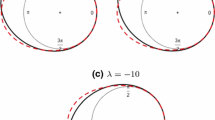Abstract
Stationarity in one form or another is an essential characteristic of the random function in the practice of geostatistics. Unfortunately it is a term that is both misunderstood and misused. While this presentation will not lay to rest all ambiguities or disagreements, it provides an overview and attempts to set a standard terminology so that all practitioners may communicate from a common basis. The importance of stationarity is reviewed and examples are given to illustrate the distinctions between the different forms of stationarity.
Similar content being viewed by others
References
Alfaro, M., 1979, Etude de la robustesse des simulations de fonctions aleatoires; Doc-Ing. Thesis, Centre de Geostatistique, ENSMP, 161 p.
Alfaro, M., 1984, Statistical Inference of the Semivariogram and the Quadratic Model, p. 45–53in G. Verly, M. David, A. G. Journel, and A. Marechal (eds.), Geostatistics for Natural Resources Characterization: D. Reidel, Dordrecht, The Netherlands.
Armstrong, M., 1984a, Improving the Estimation and Modelling of Variograms, p. 1–20in Geostatistics for Natural Resources Characterization: D. Reidel, Dordrecht, The Netherlands.
Armstrong, M., 1984b, Problems with Universal Kriging: Math. Geol., v. 16, p. 101–108.
Chauvet, P., 1984, Analyse structurale directe d'une FAI-k a une dimension: Sci. Terre, v. 21, p. 125–137.
Chauvet, P., 1985, Les variogramme h et les covariances d'accroissements associées: Internal Report N-952, Centre de Geostatistique, Fontainebleau, 6 p.
Chauvet, P., 1986, Covariances d'accroissements associées aux modeles monomias des FAI-k: Internal Report N-997, Centre de Geostatistique, Fontainebleau, 22 p.
Chiles, J. P., 1976, How to Adapt Kriging to Non-Classical Problems: Three Case Studies; p. 69–90in M. Guarascio, M. David, and C. Huijbrechts (eds.), Advanced Geostatistics in the Mining Industry: D. Reidel, Dordrecht, The Netherlands.
Cliff, A. D.; and Ord, J. K., 1981, Spatial Processes: Models and Applications: Pion, London, 266 p.
Cox, D. R.; and Miller, H. D., 1965, The Theory of Stochastic Processes: Methuen, London, 398 p.
Cressie, N., 1985, When Are Relative Variograms Useful in Geostatistics?: Math. Geol., v. 17, p. 693–702.
Cressie, N., 1986a, In Search of Generalized Covariances for Kriging: Joint Statistics Meeting, Chicago, 21 August, oral presentation.
Cressie, N., 1986b, Kriging Non-Stationary Data: J. Am. Stat. Assoc., v. 81, p. 625–633.
Delfiner, P., 1976, Linear Estimation of Non-Stationary Phenomena, p. 49–68in Advanced Geostatistics in the Mining Industry: M. Guarascio, M. David, and C. Huijbrechts (eds.), D. Reidel, Dordrecht, The Netherlands.
Diamond, P.; and Armstrong, M., 1984, Robustness of Variograms and Conditioning of Kriging Matrices: Math. Geol., v. 16, p. 809–822.
Journel, A.; and Froideveaux, R., 1982, Anisotropic Hole-Effect Modelling: Math. Geol., v. 14, p. 217–240.
Kitanidis, P., 1983, Statistical Estimation of Polynomial Generalized Covariance Functions and Hydrologic Applications: Water Resour. Res., v. 19, pp. 901–921.
Kitanidis, P., 1985, Minimum Variance Unbiased Estimation of Covariances of Regionalized Variables: Math. Geol., v. 17, p. 195–208.
Matheron, G., 1971, The Theory of Regionalized Variables and Its Applications: Center for Geostatistics, Fontainebleau, 212 p.
Matheron, G., 1973, The Intrinsic Random Functions and Their Applications: Adv. Appl. Probability, n. 5, p. 439–468.
Matheron, G., 1978, Estimer et Choisir: Fasc. 7, Centre de Geostatistique, Fontainebleau, 175 p.
Myers, D. E., 1985, On Some Aspects of Robustness: Sci. Terre, n. 21, p. 63–79.
Myers, D. E., 1986, The Robustness and Continuity of Kriging: Joint Statistics Meeting, Chicago, 21 August, oral presentation.
Neuman, S.; and Jacobson, E., 1984, Analysis of NonIntrinsic Spatial Variability by Residual Kriging with Application to Regional Groundwater Levels: Math. Geol., v. 16, p. 499–521.
Olea, R., 1972, Application of Regionalized Variable Theory to Automatic Contouring: Kansas Geological Survey, Lawrence, Kansas, 191 pp.
Philip, G. M.; and Watson, D. F., 1986, Matheronian Geostatistics: Quo Vadis: Math. Geol., v. 18, p. 93–117.
Sabourin, R., 1976, Application of Two Methods for the Interpretation of the Underlying Variogram, p. 101–112in A. Guarascio, M. David, and C. Huijbrechts (eds.), Advanced Geostatistics in the Mining Industry: D. Reidel, Dordrecht, The Netherlands.
Srivastava, Rae Mohan, 1987, A Non-Ergodic Framework for Variograms and Covariance Functions: M.S. Thesis, Applied Earth Sciences, Stanford University, p. 113.
Starks, T. H.; and Fang, J. H., 1982a, On Estimation of the Generalized Covariance Function: Math. Geol., v. 14, p. 57–64.
Starks, T. H.; and Fang, J. H., 1982b, The Effect of Drift on the Experimental Variogram: Math. Geol., v. 14, pp. 309–319.
Von Neumann, J.; Kent, R. H.; Bellision, H. R.; and Hart, B. I., 1941, The Mean Square Successive Difference: Ann. Math. Stat., v. 12, p. 153–162.
Webster, R.; and Burgess, T. M., 1981, Optimal Interpolation and Isarithmic Mapping of Soil Properties. III. Changing Drift and Universal Kriging: J. Soil Sci., v. 31, p. 505–524.
Author information
Authors and Affiliations
Rights and permissions
About this article
Cite this article
Myers, D.E. To be or not to be... stationary? That is the question. Math Geol 21, 347–362 (1989). https://doi.org/10.1007/BF00893695
Received:
Accepted:
Issue Date:
DOI: https://doi.org/10.1007/BF00893695




